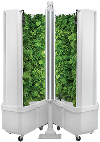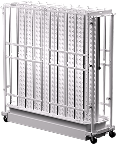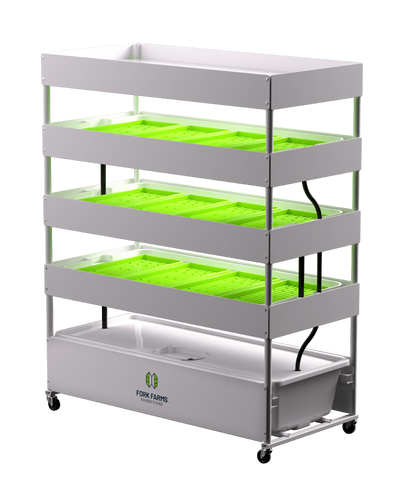What Are The Best Hydroponic Gardens for Teachers and School Administrators?
Hydroponics in schools is like adding a sprinkle of magic to the curriculum. It's hands-on learning at its finest, teaching students about science, nutrition, and sustainability all while they get their hands a little dirty. Plus, it's a fantastic way to grow plants indoors without needing a garden space. And, hopefully, hydroponics yields some fresh vegetables so it can be a source of hyper-local nutrition for students and school staff.
Teachers and administrators are some of the most busy people around, so the last thing they are looking for is more work and complication. Therefore, when looking for a hydroponic garden for the school, it’s important to find a system that does not require a great deal of time to install, manage, maintain, harvest, and serve. Teachers are pulled in many different directions and always juggling many tasks, so a hydroponic growing system should be as simple and straightforward as can be. It also needs to engage students. Students learn the most when they can participate in something new and use their hands, rather than sit and listen to a teacher speak for hours. The best hydroponic growing system for a school should spark curiosity, and offer hands-on learning opportunities and educational tools.
Where To Start In Selecting A Hydroponic System?
How to get started in figuring out what are the best hydroponic gardens for teachers and school administrators?
Ask yourself a few simple questions:
- What is your purpose in maintaining a hydroponic garden?
- Are you trying to strictly grow food or are you looking for learning opportunities around the science of hydroponics? Or, are you interested in a combination of both?
- What are your end goals regarding a hydroponic garden in your school?
- If you maintain a system, what do you plan to do with the food you grow - use the fresh food on the school cafeteria line, in cooking classes, as food donations to the local community?
The Most Common Hydroponic Gardens For Schools
Once you’ve honed in on your goals, you can explore the most common hydroponic growing options school administrators tend to choose for their schools:
- Countertop Gardens - These are very compact and easy to set up. They are an ideal option if you want a basic, small system in the classroom, and if you are not focused on yielding a big harvest or adopting a robust learning curriculum
- Vertical Farms or Tower Farms - These vertical, beautiful blooming towers are space-savers and can turn a corner of the classroom into a lush veggie oasis. Due to how beautiful they look in bloom, they often elicit great curiosity in both students and adults. They offer both educational opportunities while also growing fresh foods such as lettuces, tomatoes, cucumbers, peppers, and more.
- Small DIY hydroponic systems - Some agriculture teachers have their students build their own hydroponic garden out of PVC allowing the students exposure to the engineering and science of hydroponics from beginning to end.
- Container Farms are ideal for projects that have a great deal of space and a lot of mouths to feed. These are better suited for large university settings that have big budgets as they can produce hundreds of pounds of fresh produce every week.
What Should Teachers and Administrators Look for in a Hydroponic Garden for Their School?
Simplicity, engagement opportunities, hands-on learning, durability.
Going back to what school administrators are often looking for in a hydroponic system other than simplicity and engagement is a turnkey curriculum and hands-on learning opportunities. Teachers also tend to look for a durable system that can withstand action from many hands and eyes. As mentioned before, students tend to like to tinker and explore, and this curiosity should be embraced.
In vertical hydroponic farms such as the Flex Farm, educational opportunities in the areas of STEM, nutrition, agriculture, sustainability, and health abound. The Flex Farm is easy to maintain, very engaging, and is delivered with a full, tailored K-12 curriculum for teachers and administrators. The curriculum is Next Generation Science Standard aligned, making it desirable for science teachers to add to the syllabus. A tower farm is typically designed so that anyone can understand how to set it up and maintain it - even elementary-aged students. Working on the farm on an ongoing basis gives students a sense of ownership and responsibility knowing that the project is theirs from start to finish. The Flex Farm is also paired with an online community resource hub called, Farmative, which is stocked with “how to” videos, a forum, and many resources for both teachers and students.
Teachers have been known to use vertical hydroponic farms in many areas of a school and classroom such as biology classes, nutrition and cooking, health classes, sciences, marketing, and even in literacy lessons. It is ultimately up to the teacher to get creative and think out of the general science box to engage students on a variety of different subject matters, even how to combat climate change. In many cases, learning from a hydroponic farm can be thought of as whole, comprehensive learning. There’s usually a job for everyone!
Bonus - Vertical hydroponic farms are also easy to clean and can be cleaned and shut down during the summer months if need be. The parts in the Flex Farm are dishwasher-safe and can be cleaned in the school's food service dishwashers.
Real-Life Educational Stories with Hydroponic Farms
School administrators have also found out that hydroponic farms can be valuable in special needs classes as the sound of the water filtering through the system often has calming effects on students. Check out this video from Mentor High School to see student enthusiasm firsthand about hydroponics in their classroom.
Englewood, CO School District uses five Flex Farms in all of its elementary schools and in one high school as one of many steps the district is adopting to create PK-12 system-wide alignment with regard to student understanding of STEAM and Career and Technical Education opportunities. The district’s STEAM learning experiences are designed to focus on six available pathways for students when they enroll in high school: Engineering/Manufacturing/Design, Digital Media, Visual and Performing Arts, Biomedical Sciences, Computer Science, and Sustainable Agriculture and Green Energy (SAGE). Cherrelyn Elementary School hosted a harvest event back in December that was covered by CBS News.
The bottom line is that learning opportunities proliferate with any kind of hydroponic garden that is placed in a school. The multi-purpose hydroponic gardens that can offer educational openings, as well as fresh food and nutrition, are on top of our list.
Special thanks to inspiration from Terry Wetzel, Associate Vice President, Partnership Development, at Fork Farms on this blog piece. Terry has more than 20 years of rewarding experience in the education profession as a teacher and administrator at various districts in Northeastern Wisconsin. When he left his teaching career at the end of the 2022 school year, he was looking for a new challenge and specifically wanted to be part of a value-driven company with a positive culture.
Important Links:
























